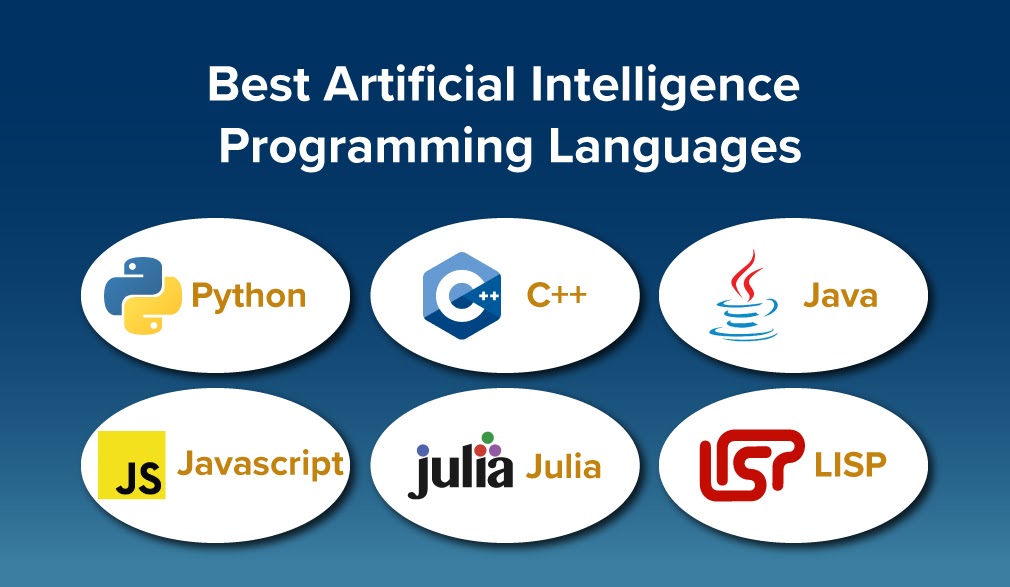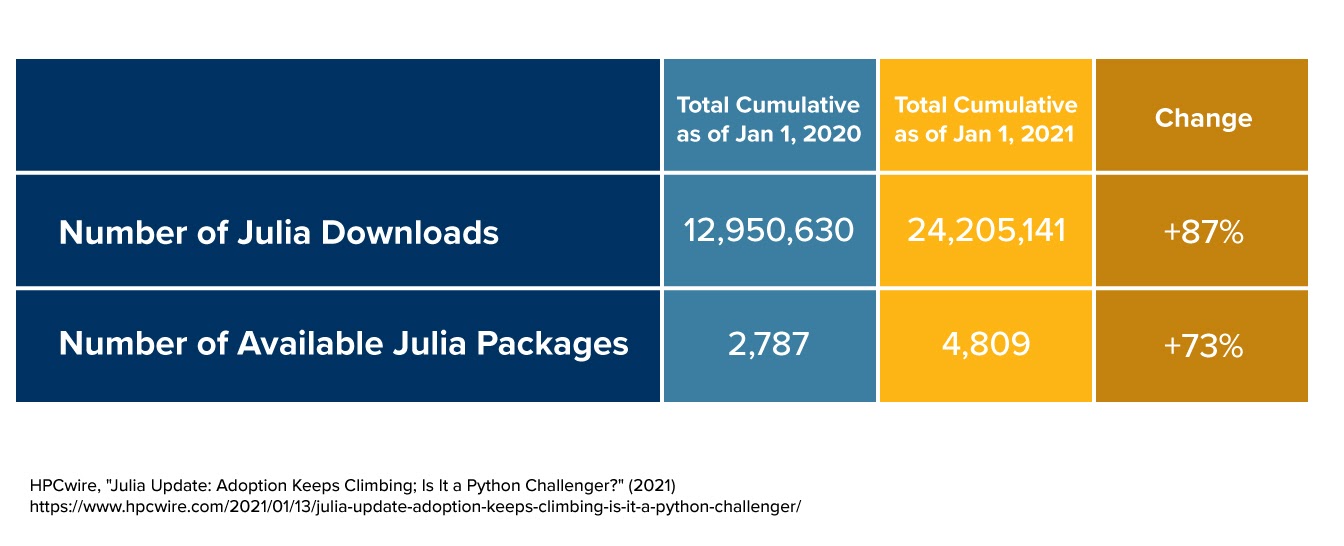Top 6 AI Programming Languages to Learn in 2023

Artificial intelligence (AI) is an essential element of many software development projects that allows developers to create software that can perceive, learn, reason and solve problems — much in the way a human mind operates. Learning how to apply artificial intelligence is critical for many job roles, especially for those interested in pursuing a career in programming.
Choosing the right language can help you get a leg up in this quickly growing field, but many people struggle with where to begin. However, getting a start now can help you ride the waves of change into the future. To help you plan your studies, we’ve analyzed the major programming languages and identified those which are best suited for artificial intelligence development. As you read, keep in mind that AI is still a relatively new innovation, so what’s considered the industry standard in programming today could change over the next few years.
If you’re interested in AI programming but unsure where to get started, there are a number of options for anyone wanting to learn to code, including self-teaching applications, coding bootcamps or full-time college degree programs. Below, we’ll cover the top options for learning AI-focused programming, as well as the best languages to learn for AI development.
How to Make an AI
The creation of artificial intelligence implementations has made it possible to introduce tools and solve problems in new and complex ways. However, it’s not an all-encompassing solution to every programming challenge out there — making a program that utilizes AI requires careful thought and planning.
The first thing to consider when building an AI is the problem. Ask yourself: What issue am I trying to solve? What is the desired outcome of the solution? Your answers to these questions can drive you toward different AI-focused solutions, like machine learning (ML) for data processing or using computer vision (CV) to derive meaningful information from digital images and videos.
The next step is to consider the amount and type of data that you’re processing using AI. Artificial intelligence algorithms are powerful, but they’re not magical. If poor-quality data is fed into the system, it’s unlikely to produce the desired results. Be sure your data has been checked, cleaned and organized according to any specified requirements.
AI is a broad field with many wide applications. The best option for you will depend on the specifics of your project, as different programming languages excel at various AI-related tasks. Choosing the appropriate programming language depends on what you need to accomplish within a specific application.
Best Artificial Intelligence Programming Languages
Many general-purpose programming languages can be used in a variety of situations, including AI applications. If you’re interested in learning more about developing machine learning and artificial intelligence applications, you’ve come to the right place.
Below, we’ll discuss the most widely used and desired programming languages for artificial intelligence. These languages include Python, Java, C++, JavaScript, Julia and LISP. As we mentioned above, this list will likely change as the field continues to grow, but these languages are also used in general programming, meaning they’ll continue to be valuable in the world of programming, regardless of their standing in AI development.

How to Learn AI Programming
While artificial intelligence was once a subject only the most advanced computer science researchers were familiar with, AI concepts are becoming more commonplace throughout the programming field.
There are many ways to learn artificial intelligence concepts, including traditional college degree programs, independent study, and coding bootcamps. Keep in mind that before you dive into AI-related topics, it’s good to have a foundational understanding of programming knowledge, as artificial intelligence builds on existing fundamentals. That said, coding bootcamps are a great choice for those who want to learn web programming quickly through hands-on experience.
If you’re interested in learning more about web development languages that can be applied in artificial intelligence, consider signing up for Berkeley Coding Boot Camp.
AI Programming With Python
As a programming industry standard with a mature codebase, Python is a compelling and widely used language across many programming fields. It’s considered a great beginner’s language — many developers learn Python as one of their first programming languages. As such, there’s a large developer community built around coding for AI-focused applications.
Why Is Python Used for AI?
Python is a powerful tool for data analysis, making it key for AI development. According to HackerRank, it’s one of the most in-demand programming languages that exists in the market today. Coders and data analysts love Python for its flexibility, intuitive design and versatility. While it’s designed to address complex tasks, it is a language that is considerably easy to learn and apply to your own projects.
Many Python libraries were designed to classify and analyze large data sets, which makes it a valuable language in both AI and machine learning.
Python AI Source Code
Python is very adaptable and can be used for many machine learning and AI-focused applications — you can find a repository of practical AI-focused projects on GitHub.
Another AI-focused codebase can be found on TensorFlow — a large, open-source machine learning library developed by Google. This intuitive library helps programmers build and train machine learning models quickly and easily, allowing developers to research and test out new ML implementations.
AI Programming With Java
Java is an incredibly powerful language used across many software development contexts. It’s especially prevalent in the mobile app space, where many applications are taking advantage of artificial intelligence features. Java is simple to use and debug, and it’s great for multi-platform deployments with its “write once, run anywhere” model, making it a great language for enterprise-level software applications, neural networks and artificial intelligence platforms.
How to Make an AI in Java
Java is a popular programming language that offers AI developers a wide range of benefits, including easy debugging, usability and maintainability. It has a built-in garbage collector that automatically deletes useless data and facilitates visualization. It also features Swing, a GUI widget toolkit; and Standard Widget Toolkit (SWI), a graphical widget toolkit. Java is also cross-platform, which allows for AI-focused projects to be deployed across many types of devices.
One example of an AI project that uses Java is Deeplearning4j (DL4J) — a major open-source deep-learning library that uses Java. Deep learning is a sub-field of machine learning that allows a program to mimic human learning and is typically used to group or cluster data and make predictions.
Java AI Code
The Deeplearning4j GitHub provides a variety of examples of how the library operates and how to start coding using its tools. The examples page showcases many implementations of the library, from training a neural network to remember a string of characters, to deciphering captchas. The library shows the depth of what you can achieve when using Java for AI development.
AI Programming With C++
C++ is a popular programming language known and loved for its speed and efficiency. It executes code quickly, making it an excellent choice for machine learning and neural network applications. Many AI-focused applications are relatively complex, so using an efficient programming language like C++ can help create programs that run exceptionally well.
How to Make an AI in C++
C++ isn’t always the first choice for AI-focused applications, but it’s so widely used throughout the industry that it’s worth mentioning. This language runs and executes very efficiently, but the trade-off is that it’s more complex to write. This makes C++ a great choice for resource-intensive applications, where it is occasionally used in combination with other languages to build AI-focused applications.
One example of a tool that uses C++ for AI-focused applications is the library OpenCV. This library supports multiple programming languages, including C++, and it’s one of the largest machine learning and computer vision libraries available. Computer vision algorithms can take in video input and identify information using algorithms — they can identify objects, recognize faces, produce 3D scans of real-life objects and so much more.
C++ Code for AI
OpenCV offers an in-depth documentation guide to help programmers get up to speed with how to use C++ in your artificial intelligence projects. There are many different modules and algorithms available, including object detection, analyzing motion or object tracking in video and machine learning.
AI Programming With JavaScript
According to GitHub’s rankings, JavaScript is the most popular programming language in the world. That shouldn’t come as a surprise since it’s a significant contributor to the modern web, responsible for powering much of the interactivity found in the websites we use every day. It’s a reliable option for any web developer because it’s relatively easy to learn, and is a promising choice for beginners learning AI or general web development.
How to Make an AI in JavaScript
Why is JavaScript a good fit for artificial intelligence? It has multiple high-level tools and libraries for machine learning. A good example is TensorFlow.js, which runs directly within the browser and opens up many possibilities for web developers. Building your knowledge of browser-based AI applications can help you build next-generation AI-focused browser tools.
JavaScript AI Code
The TensorFlow.js demo section provides a list of examples of AI programs and their accompanying code, all running in-browser. Some of the examples include a lip-syncing scoring application and a piano application that automatically generates music — just a few of the near-infinite applications for browser-based AI technology.
AI Programming With Julia
Many programming applications require two or more programming languages, one with high performance (e.g., C++) and one that makes programming less complex (e.g., Python). While this process works, it also produces a push and pull between the two concepts. Beyond this, many programming languages have decades of design and building behind them. This can be beneficial in some ways, but it can also lead to messy issues over time. Conceived in 2009 at MIT, Julia aimed to fix some of these problems.
The first version of Julia was officially introduced to the programming space in 2018 and has steadily been gaining popularity ever since. According to HPCwire, the number of downloads for the language grew by 87 percent from 2020 to 2021, and the number of available packages for the language grew by 73 percent.

How to Make an AI in Julia
The artificial intelligence applications for Julia continue to grow over time. Flux is a major machine learning and AI stack written for Julia. Some of the features that make Julia great for AI programming include a built-in package manager and support for parallel and distributed computing.
Julia is especially helpful for scientific computing and data analysis. The language supports parallelism, a type of computing where many different processes are carried out simultaneously. This is an important concept for machine learning and AI-focused applications, meaning that Julia could continue to grow in importance throughout the field.
Julia AI Code
Julia’s AI ecosystem is growing, but isn’t quite as big as some of the options available for other major programming languages. The Flux website lists some of the capabilities and tools available in the library that can be applied to AI projects, including computer vision tools, reinforcement learning tools and more.
AI Programming With LISP
LISP is widely used in artificial intelligence development. It’s the second-oldest programming language with a strong history of providing dynamic and custom solutions for programming challenges. The progress, development and evolution of LISP is closely related to the early progress and development of AI.
LISP isn’t the most frequently used AI programming language in a modern context, but that doesn’t mean it’s not used at all. While it may not be as common as some of the other languages mentioned so far, learning LISP can help you understand artificial intelligence more deeply and thoroughly, as it enables rapid prototyping and shines at handling symbolic information and lists.
Why Is LISP Used for AI?
Some developers love using LISP because it’s fast and allows for rapid prototyping and development. LISP and AI go way back — it was developed in the 1950s as a research platform for AI, making it highly suited for effectively processing symbolic information.
LISP is an excellent prototyping tool that’s a great fit for solving problems that you don’t yet know how to solve.
LISP AI Code
One of the reasons LISP isn’t the most commonly used programming language for AI any longer is partially due to a lack of well-developed modern libraries and a syntax that’s very different from many other programming languages. When it was first introduced, LISP was ahead of its time, but it has mostly been replaced by other languages. However, familiarity with LISP can still help you understand AI more thoroughly and produce better results through your work.
Learn the Best Programming Languages for AI Today
The proliferation of artificial intelligence has had a major impact on the field of software development, and its importance will continue well into the future. Artificial intelligence, machine learning, deep learning and related technologies are advancing quickly, and their influence on the lives of people around the world will continue to grow as well. The future is bright for this technology, and software developers who are interested in entering the field should take note. The best is still yet to come, and picking up AI skills can have a major impact on your career.
You have many programming languages to choose from when learning about AI programming, and the best fit for you will depend on how easy or technical you want the process to be. If you already have experience with a specific language, your existing knowledge can provide a great foundation for additional learning. Another option is to look at popular implementations of AI used in the real world — what languages are they using?
Learning the skills to develop AI applications is critical for modern programmers. Completing a coding bootcamp, such as Berkeley Coding Boot Camp, can jump-start your coding proficiency and teach you about concepts like artificial intelligence, browser-based programming technologies, server-side development, working with databases and more.
 Live Chat
Live Chat